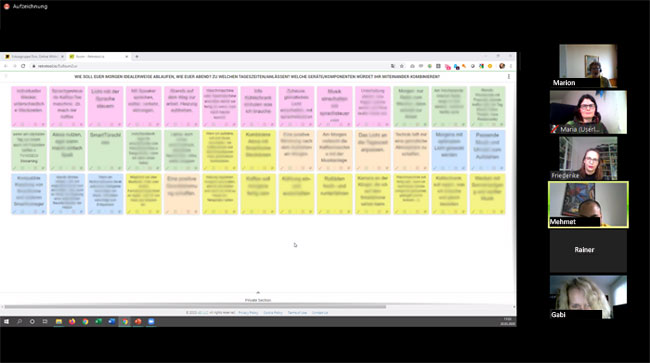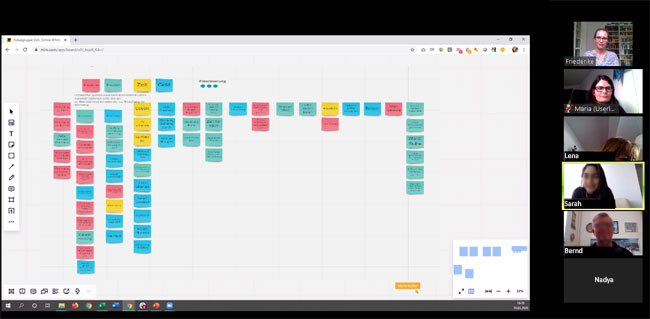Suddenly there is a deafening drilling noise – “Is the neighbour drilling through your ceiling right now?” – then the camera image and the sound hangs and Rolf leaves the video conference. Immediately wild speculations start about whether the neighbour has now finally pierced the pipe and we will not see Rolf again tonight.
Such experiences certainly abound in the days of Corona, but in this case it happened during a focus group.
Remote focus groups in times of Corona
We had four focus groups planned for a research project at our site – and then a week before, Corona got in the way. It quickly became clear that the discussion rounds could not take place as planned. Procrastination wasn’t the answer either, though. So remote?
Remote UX testing, whether moderated or unmoderated is in our DNA, so to speak, so we didn’t shy away from the challenge of running remote focus groups. We would like to share our findings and best practices with you here.
By the way, Rolf knocked again a short time later and was able to discuss further with us.
How do focus groups succeed remotely?
This is certainly the question facing many user-researchers at the moment. And we also had some concerns beforehand, but in the end (almost) everything worked out wonderfully.
We actually see some advantages over on-site focus groups:
- Supraregional test persons: With remote focus groups there are no location dependencies – the test subjects can be distributed throughout Germany or even worldwide.
- Screen sharing: Instead of nine people jostling in front of a whiteboard or flipchart full of Post-Its, everyone sees the same section of the screen. This way it is clear to all test persons what is being discussed and nobody blocks the view.
- Less documentation effort: All notes are directly digitized. This means that no further time needs to be scheduled for logging and you can make deductions directly from the notes.
Our concern that slow internet connections would prevent lively discussion was not borne out! Test subjects complemented and contradicted each other without much delay in transmission. In fact, it was barely noticeable that they were only participating virtually.
That said, there are a few target groups where we would advise on-site focus groups:
- Low technology affinity: Some target groups are less tech-savvy and may not trust themselves to have remote discussions, e.g. older people.
- No internet connection: There are still some people who do not have an internet connection, this can also be the case with elderly people among others.
- Slow Internet connection: A trouble-free webcam and screen transmission should be guaranteed at all costs, which is why the Internet speed should be checked for rural target groups, for example.
By the way, focus groups are not always the right method: Why focus groups often explore the wrong things
However, since we wanted to generate new ideas for our client and involve the target group in this process, focus groups were a good fit for us.
But now for the best practices we derived from our remote focus groups.
Best practices for remote focus groups
Meticulous preparation is the key
Improvisation is much more difficult in remote focus groups than on-site, so be prepared for any eventuality:
- Ask for technical prerequisites in the screening process: In most cases, the test persons are selected according to certain criteria anyway. Be sure to add questions about technical requirements to this screening process. Are the subjects willing to use their own computer for the session and to download software if necessary? Is a microphone available, better yet a headset? Do the test subjects have a webcam and are they willing to turn it on during the session?
- Create a quiet environment: Before starting the focus group, make sure that all test persons are in a quiet place and are not distracted by children, partners, pets or other housemates in between.
- Streaming ban: Ask subjects to stop all downloads and streaming activities in the home during the focus group. Otherwise, it ends up failing because the kids are watching Netflix in the next room.
- Easily over-recruited: Across all four focus groups, we had to exclude two subjects before launch because we could not resolve their technology issues or their internet connection was not stable. Therefore, expect a small failure rate and recruit one additional test person per focus group.
Find the right tools
On the ground, focus groups are very interactive. Not only is there discussion, but ideas are also written on Post-Its and clustered together, for example. Therefore, consider which forms of interaction you want to use and how they can be implemented remotely.
For example, we used a tool with which the test persons first collected their ideas on their own and only then did these become visible to everyone. We were then able to discuss the ideas and cluster them together. This also has the advantage that all test persons see the same thing and no one blocks the others’ view of the whiteboard or the writing is too small or illegible.

First, participants individually collected their notes.

And then we discussed and clustered them together.
Division into moderator and documenter
As with on-site focus groups, there should be a facilitator and a documenter. The moderator concentrates completely on leading the conversation. He should also keep an eye on the videos of the test persons in order to interpret facial expressions and gestures.
The documenter takes notes throughout the session. These are the specifics for facilitators and documenters in remote focus groups:
- Recognizing distractions: Remotely, it is more common for subjects to be distracted by what is happening at home or on their laptop. The moderator ‘s job is to recognize this, address the subjects on it, and bring their focus back to the discussion.
- Solve technical problems: The facilitator is responsible for identifying when there are technical problems. A few instructions the facilitator had to give in our focus groups: “Feel free to turn off the camera for a moment if your child is walking through the frame and you’re uncomfortable.”, “I can see your lips moving, but I can’t hear you. Is your mic off maybe?”. Technical problems often affect only individual test persons. In order for the moderator to remain focused on the discussion, the documenter should resolve the issues with the test subjects in a separate chat.
explain discussion rules
At the very beginning of the focus group, the rules of discussion are discussed – this applies both on-site and remotely. In addition to rules such as letting people talk and not messing up, remote-specific rules should also be added, e.g. “put your smartphone in flight mode or in the next room so as not to be disturbed”.
Share screen
The moderator should share his screen and take notes of what the subjects say. This makes the significance of their statements clear, which also motivates other test persons to contribute. It also helps the subjects keep track of what has already been said.
Important: To avoid accidentally sharing company information, it’s best to turn off notifications.
What is not intended for the eyes of the test persons, the documenter writes down.
Motivate lively discussion
Feel free to make a few jokes in between to lighten the mood. In this way, the test subjects dare to go wild when generating ideas without fear of being judged.
Encourage subjects to say something as soon as they think of something or disagree. Avoid simply taking the test subjects in turns, but do address the quieter participants directly every now and then.
Conclusion: focus groups also succeed remotely and even have some advantages!
We have to admit, we were a little surprised ourselves at how smoothly our focus groups went. With the right preparation, the right tools and a few special skills, nothing stands in the way of remote focus groups and we will certainly be using this method more often after Corona.
Can we assist you with the implementation?
You want to collect ideas for a new or existing product and involve your target group, but are unsure whether focus groups are the right method for you?
You do not only want to gather test persons from your city, but you want to conduct focus groups all over Germany or even worldwide, but you are unsure how and with which tools?
Do you need the support of experienced moderators for your focus groups?
We will be happy to advise you free of charge and without obligation:
your contact

Mathias Liesegang
UX Specialist & Account Manager
030 / 544 870 24
(Mon to Fri from 9 am to 6 pm)



Share
Share this article